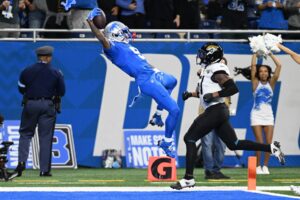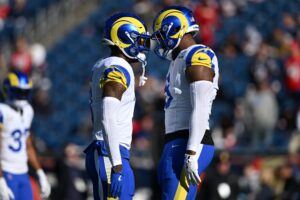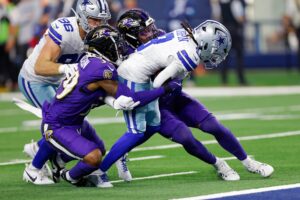It doesn’t matter which way you look at it. The Buffalo Bills offense is a different level of putrid in 2018.
It’s hard to disagree with that notion nine games into the season. A simple perusal of the Bills’ final point total in each of their games pretty much confirms a shocking inability to score.
In just two games this year have the Bills registered 20+ points. If not for Josh Allen‘s first career touchdown pass against the Los Angeles Chargers, Buffalo’s surprising win over the Minnesota Vikings the following week would be the only such contest.
Even more concerning, opposing teams have held the Bills to single-digit points in five of their nine games. It includes the past three, all downright embarrassing offensive efforts made all the more forgettable considering the opponent outscored them by a combined 101-20.
Heading into their Week 10 clash with the New York Jets, the Bills are averaging 10.7 points per game. To put that in perspective, the only teams since 2000 to manage under 11 points per game are the 2009 St. Louis Rams and the 2000 Cleveland Browns. A variety of factors are conspiring to hold the offense down this season.
The 2018 Buffalo Bills Offense Is on Pace to Be Historically Bad
The Nathan Peterman Horror Show
The lack of continuity at quarterback is certainly a contributing factor. After Nathan Peterman stunk up the joint in the season-opener, head coach Sean McDermott turned to Allen. Then he injured his elbow against the Houston Texans which precipitated more disastrous quarterback play from Peterman in relief.
Derek Anderson, signed in early October, started the next two games but suffered a concussion in a loss to the New England Patriots. It left McDermott no other choice but to start Peterman when the Bills welcomed the Chicago Bears to Orchard Park in Week Nine. As a result, any Bills fan who started the Bears defense in his/her fantasy league came out of this week with at least some modicum of satisfaction.
It’s fairly apparent at this point that Peterman isn’t even at the level to back up an NFL starting quarterback let alone start himself. He’s managed just a single touchdown pass this season all the while throwing a whopping seven interceptions. There’s a certain metric that does a good job reinforcing the disastrous nature of his time behind center.
That stat is interception percentage. It’s basically the ratio of interceptions thrown to total pass attempts. Peterman’s currently stands at 8.6 percent. Should he not improve on that number, he would be the first quarterback in 30 years to throw at least 80 passes in a season and finish with an interception percentage above 8.5 percent. The last such quarterback to do so was Steve Grogan of the Patriots back in 1988.
Obviously, the struggles at quarterback are part of a “same old story” situation for the Bills franchise. But it’s not the only reason the offense is so abjectly atrocious this year.
A Receiving Corps That Can’t Get Open
Let’s not sugar coat it. The Bills receiving corps is the worst in the NFL. A look at the rudimentary statistics gives an indication. Buffalo wide receivers are accounting for just 177 yards of offense per game and have found the end zone just three times. Both of those marks rank dead last in the league. And of the receivers on the roster, there’s not a bigger poster child for the sad state of affairs than Kelvin Benjamin.
Simply put, Benjamin isn’t catching a lot of the balls thrown his way. Through nine games, his catch percentage (catches/targets) stands at 37.7 percent. Want to know how horrifically bad that is? New Orleans Saints receiver Michael Thomas currently leads the NFL with an 88.6 percent catch percentage. And there are 47 players who’ve garnered at least 50 targets up to this point who’ve caught at least 50 percent of passes thrown to them.
If Benjamin’s catch percentage numbers don’t improve, he’s on pace to join some dubious company. Only six players since 2000 who’ve been targeted at least 80 times have finished with a catch percentage under 40 percent. Truth be told, if you’re putting up numbers akin to Devin Aromashodu‘s 2011 campaign, things aren’t going well. But that’s exactly the company Benjamin’s associated with as a result of his less than savory exploits this year.
But he’s not the only culprit. The receiving corps as a whole struggles immensely when it comes to consistently getting open. Per NFL’s Next Gen Stats, the Bills ranks third worst in the NFL in average separation per target among their pass catchers. Still, Benjamin epitomizes these problems since he ranks dead last in this category among receivers with at least 25 targets. It only serves to exacerbate the Bills’ quarterback issues.
A Sieve of an Offensive Line
It’s an oft-used cliche, but that’s because it’s invariably true. Football is a team game. And the most underrated yet immensely important element to a football team’s success is the offensive line. Just look at the Patriots. Part of Tom Brady‘s effectiveness now that he’s in his 40s relates to the fantastic pass protection he receives on a consistent basis. Consequently, what’s held Andrew Luck back in recent years is the poor performance of the Indianapolis Colts‘ line.
There are quite a few easy scapegoats for the ineptness of the Bills offense. The issues at quarterback, particularly when Peterman’s behind center, fall into that category. Add in the inability of the receivers to get anything going and there’s plenty of blame to go around. But don’t absolve the offensive line because their inability to dictate at the line of scrimmage is a significant contributing factor to the offensive malaise.
Before Josh Allen injured his elbow, he was on pace to be the most sacked quarterback since David Carr for the Texans in 2002. As it is, the Bills’ 3.7 sacks allowed per game ranks 30th in the league. But a dive into the deeper stats also paints a troubling picture regarding the O-line’s performance. For this, we need to look at the Pro Football Focus player grades for each position on the line. Taking the ranking of the players who’ve seen the most snaps and subsequently averaging those five numbers gives a robust indication of how the unit’s performing as a whole.
A little number-crunching in that regard produces the following visual.


What’s telling here is that most of the units getting high marks from PFF are part of teams in playoff contention. You could make the argument that around three-quarters of the teams in the upper chart have a chance to make the postseason. The same can’t be said of the bottom one that includes the Bills who rank third from bottom in what we can call PFF composite offensive line rankings. It further underscores the dreadful nature of Buffalo’s offense in 2018.
A Potent Concoction of Terrible and Its Historical Context
All of this is conspiring to create a season of historic proportions in regard to offensive ineptitude. That’s particularly true with regard to the passing game. There’s a certain advanced efficiency metric that the site Football Outsiders measures which showcases the Bills’ near-unprecedented struggles with that aspect of their offense. It’s known as defense-adjusted value over average (DVOA). The most basic definition of DVOA is that it measures how effective a given team is on a situational basis.
Teams are measured relative to a baseline that stands at 0. So those who perform well receive a positive percentage whereas a negative percentage goes to those who struggle. In addition to DVOA statistics for both the offense and defense as a whole, Football Outsiders also tracks DVOA for passing and rushing offense as well as teams’ ability to defend the pass and run. And to put it in blunt terms, the numbers the Bills’ pass game are generating are downright offensive.
Through nine games, Buffalo’s pass offense DVOA stands at -72.5 percent. If that number doesn’t improve between now and the end of the season, it would be the lowest since at least 1986 which is the first season that Football Outsiders has DVOA data for. The previous low was the 1992 Seattle Seahawks, who finished with a -65.3 percent pass offense DVOA. Basically, the 2018 Bills offense is the NFL equivalent of a dangerous, destructive storm system that comes along every 25 years or so.
Last Word
2018 was always going to be a struggle for this team. Their salary cap situation, particularly the $50 million+ in dead money on their books, precluded the Bills from fielding a roster of optimum competitiveness this season. A quarterbacking group that includes an inexperienced rookie, a washed up veteran and a guy clearly in over his head isn’t helping. One can only hope that general manager Brandon Beane takes advantage of the massive amount of cap space he’ll have in 2019 by putting together a roster that can build upon what the team accomplished last season.






